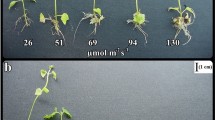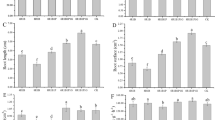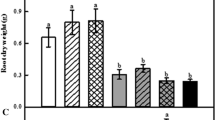Abstract
The aims of this study were to evaluate how different light qualities alter the physiological and biochemical characteristics, of Dendrobium nobile. To determine the best light quality for in vitro culture of D. nobiles plantlets, the relationships between growth, antioxidant capacity, nutrient and chlorophyll contents, and chlorophyll fluorescence were evaluated. Growth under five Light-Emitting Diode (LED) light treatments, red light (R), blue light (B), 8R:2B, 7R:3B, and 5R:5B, were compared to white fluorescent light. The 8R:2B and 7R:3B mixtures of red and blue LED light were beneficial to root number, root length, root activity, fresh and dry weight, antioxidant ability, and chlorophyll content and fluorescence. The carotenoid content and ΦPSII significantly correlated with root length, while NPQ significantly correlated with root activity, length of root, fresh and dry weight and SSC. qP was significantly correlated with fresh and dry weight and the activities of FPC, POD and APX. Comprehensive scores, derived from Principal Component Analysis (PCA), of the plants grown under the 8R:2B and 7R:3B light treatments were similar to each other, while significantly higher than plants grown under the other light treatments. In conclusion, D. nobile seedlings grown under 8R:2B and 7R:3B exhibited suitable plant architecture for the controlled environment.




Similar content being viewed by others
References
Abdul AM, Adel Ahmed ABUL-SOAD, Ghulam SM (2017) In vitro rooting of Dendrobium nobile orchid: Multiple responses to auxin combinations. Notulae Scientia Biologicae 9(1):1–6. https://doi.org/10.15835/nsb919894
Ahmadi T, Shabani L, Sabzalian MR (2020) LED light mediates phenolic accumulation and enhances antioxidant activity in Melissa officinalis L. under drought stress condition. Protoplasma 257(4):1231–1242. https://doi.org/10.1007/s00709-020-01501-4
Akcin A, Yalcin E (2016) Effect of salinity stress on chlorophyll, carotenoid content, and proline in Salicornia prostrata Pall. and Suaeda prostrata Pall. subsp. prostrata (Amaranthaceae). Braz J Bot 39:101–106. https://doi.org/10.1007/s40415-015-0218-y
Araceli BM, Marta BM, Alfonso GC (2022) Effect of LED lighting on physical environment and microenvironment on In vitro plant growth and morphogenesis: The need to standardize lighting conditions and their description. Plants Basel 11(1):60–95. https://doi.org/10.3390/plants11010060
Baroli I, Price GD, Badger MR, Susanne CV (2008) The contribution of photosynthesis to the red light response of stomatal conductance. Plant Physiol 146(2):737–747. https://doi.org/10.1104/pp.107.110924
Batista DS, Felipe SHS, Silva TD, Castro KM, Mamedes-Rodrigues TC, Miranda NA, Ríos-Ríos AM, Faria DV, Fortini EA, Chagas K, Torres-Silva G, Xavie A, Arencibia AD, Otonia WC et al (2018) Light quality in plant tissue culture: does it matter? In Vitro Cell Dev Plant 54:195–215. https://doi.org/10.1007/s11627-018-9902-5
Cashmore AR, Jarillo JA, Wu YJ, Liu DM (1999) Cryptochromes: blue light receptors for plants and animals. Science 284(5415):760–765
Chaoui A, Mazhoudi S, Ghorbal MH, Ferjani E (1997) Cadmium and zinc induction of lipid peroxidation and efects on antioxidant enzyme activities in bean (Phaseolus vulgaris L.). Plant Sci 127(2):139–147
Chen M, Chory J, Fankhauser C (2004) Light signal transduction in higher plants. Annu Rev Genet 38:87–117
Coelho AD, Souza C, Bertolucci S, Carvalho AA, Santos GC, Oliveira TD, Marques EA, Salimena JP, Pintoet JEBP (2021) Wavelength and light intensity enhance growth, phytochemical contents and antioxidant activity in micropropagated plantlets of Urtica dioica L. Plant Cell Tiss Organ 145(2):59–74. https://doi.org/10.1007/s11240-020
Darko E, Heydarizadeh P, Schoefs B (2014) Sabzalian MR (2014) Photosynthesis under artificial light: the shift in primary and secondary metabolism. Philos Trans R Soc B 369(1640):1–7. https://doi.org/10.1098/rstb.2013.0243
Daud N, Faizal A, Geelen D (2013) Adventitious rooting of Jatropha curcas L. is stimulated by phloroglucinol and by red LED light. In Vitro Cell Dev-Pl 49:183–190
Devlin PF, Christie JM, Terry MJ (2007) Many hands make light work. J Exp Bot 58(12):3071–3077
Di QH, Li J, Du YF, Wei M, Shi QH, Li Y, Yang FJ (2021) Combination of red and blue lights improved the growth and development of eggplant (Solanum melongena L.) seedlings by regulating photosynthesis. J Plant Growth Regul 40(4):1477–1492. https://doi.org/10.1007/s00344-020-10211-3
Dong C, Fu Y, Liu G, Liu H (2014) Growth, photosynthetic characteristics, antioxidant capacity and biomass yield and quality of wheat (Triticum aestivum L.) exposed to LED light sources with different spectra combination. J Agron Crop Sci 200:219–230. https://doi.org/10.1111/jac.12059
Dutta Gupta S, Kumar A, Agarwal A (2019) Impact of light-emitting diodes (LEDs) on the growth and morphogenesis of encapsulated shoot buds of Curculigo orchioides Gaertn., an endangered medicinal herb. Acta Physiol Plant 41:50–62. https://doi.org/10.1007/s11738-019-2840-y
Eckardt NA (2001) From darkness into light: Factors controlling photomorphogenesis. Plant Cell 13(2):219–221
Fan XX, Zang J, Xu ZG, Guo SR, Jiao XL, Liu XY, Gao Y (2013) Effects of different light quality on growth, chlorophyll concentration and chlorophyll biosynthesis precursors of non-heading Chinese cabbage (Brassica campestris L.). Acta Physiol Plant 35(9):2721–2726. https://doi.org/10.1007/s11738-013-1304-z
Fang LZ, Ma ZY, Wang QB, Nian H, Ma QB, Huang QL, Mu YH (2021) Plant growth and photosynthetic characteristics of soybean seedlings under different LED lighting quality conditions. J Plant Growth Regul 40:668–678. https://doi.org/10.1007/s00344-020-10131-2
Folta KM, Childers KS (2008) Light as a growth regulator: controlling plant biology with narrow-bandwidth solid-state lighting systems. Hort Sci 43:1957–1964
Gitelson AA, Gritz Y, Merzlyak MN (2003) Relationships between leaf chlorophyll content and spectral reflectance and algorithms for non-destructive chlorophyll assessment in higher plant leaves. J Plant Physiol 160(3):271–282
Goodwin TW (1988) Distribution and analysis of carotenoids. Plant Pigments 61–132
Hamedalla AM, Ali MM, Ali WM, Ahmed MA, Kaseb MO, Kalaji HM, Yousef AF (2022) Increasing the performance of cucumber (Cucumis sativus L.) seedlings by LED illumination. Sci Rep-UK 12(1):1–12. https://doi.org/10.1038/s41598-022-04859-y
He C, Zeng Y, Fu Y, Wu J, Liang Q (2020) Light quality affects the proliferation of in vitro cultured plantlets of Camellia oleifera Huajin. Peer J 8:e10016. https://doi.org/10.7717/peerj.10016
Hernández R, Kubota C (2016) Physiological responses of cucumber seedlings under different blue and red photon flux ratios using LEDs. Environ Exp Bot 121:66–74. https://doi.org/10.1016/j.envexpbot.2015.04.001
Hogewoning SW, Trouwborst G, Maljaars H, Poorter H, van Ieperen W, Harbinson J (2010) Blue light dose-responses of leaf photosynthesis, morphology, and chemical composition of Cucumis sativus grown under different combinations of red and blue light. J Plant Physiol 61(11):3107–3117. https://doi.org/10.1093/jxb/erq132
Hsie B, Bueno AIS, Bertolucci SK, Carvalho AA (2019) Study of the influence of wavelengths and intensities of LEDs on the growth, photosynthetic pigment, and volatile compounds production of Lippia rotundifolia Cham in vitro. J Photochem Photobiol B 198:111577. https://doi.org/10.1016/j.jphotobiol.2019.111577
Hu W, Lagarias JC (2017) A tightly regulated genetic selection system with signaling-active alleles of phytochrome B. Plant Physiol 173(1):366–375. https://doi.org/10.1104/pp.16.01345
Hung CD, Chang-Hee H, Seon-Ki K, Kyu-Han L, Jea-Young P, Min-Woo N, Lee H (2016) LED light for in vitro and ex vitro efficient growth of economically important highbush blueberry (Vaccinium corymbosum L.). Acta Physiol Plant 38(6):152. https://doi.org/10.1007/s11738-016-2164-0
Isabel AR, Rodríguez-Herva JJ, Martínez PM, González-Melendi P, García-Casado G, Rodríguez-Palenzuela P, López-Solanilla E (2014) Light regulates motility, attachment and virulence in the plant pathogen P seudomonas syringae pv tomato DC 3000. Environ Microbiol 16(7):2072–2085. https://doi.org/10.1111/1462-2920.12240
Jiang L, Wang Z, Jin G, Lu D, Li X (2019) Responses of favorita potato plantlets cultured in vitro under fluorescent and light-emitting diode (LED) light sources. Am J Potato Res 96(4):396–402. https://doi.org/10.1007/s12230-019-09725-8
Johkan M, Shoji K, Goto F, Hashida S, Yoshihara T (2010) Blue light-emitting diode light irradiation of seedlings improves seedling quality and growth after transplanting in red leaf lettuce. Hort Science 45(12):1809–1814
Jordan KA, Norikane J, Takakura T (2001) Control of led to achieve light quality and intensity in tissue culture and micro-propagation studies. Acta Horticulturae Sinica 562:135–140. https://doi.org/10.17660/ActaHortic.2001.562.14
Kang WH, Park JS, Park KS, Son JE (2016) Leaf photosynthetic rate, growth, and morphology of lettuce under different fractions of red, blue, and green light from light-emitting diodes (LEDs). Hortic Environ Biote 57(6):573–579. https://doi.org/10.1007/s13580-016-0093-x
Kasperbauer MJ (2000) Strawberry yield over red versus black plastic mulch. Crop Sci 40(1):171–174
Kim HH, Goins GD, Wheeler RM, Sager JC (2004) Stomatal conductance of lettuce grown under or exposed to different light qualities. Ann Bot Lond 94(5):691–697. https://doi.org/10.1093/aob/mch192
Kirakosyan RN, Kosobryukhov AA, Tovstyko DA, Anisimov AA, Shulgina AA et al (2021) Effects of light spectral quality on the micropropagated raspberry plants during ex vitro adaptation. Plants Basel 10(10):1–24. https://doi.org/10.3390/plants10102071
Kolomeitseva GL, Babosha AV, Ryabchenko AS, Tsavkelova EA (2021) Megasporogenesis, megagametogenesis, and embryogenesis in Dendrobium nobile (orchidaceae). Protoplasma 258(2):301–317. https://doi.org/10.1007/s00709-020-01573-2
Kwon A, Cui HY, Lee H, Shin H, Kang KS, Park SY (2015) Light quality affects shoot regeneration, cell division, and wood formation in elite clones of Populus euramericana. Acta Physiol Plant 37(3):1–9. https://doi.org/10.1007/s11738-015-1812-0
Lee HS (2000) Plant physiology and biochemistry experiment principle and technology. Higher Education Press, Beijing
Lee SH, Tewari RK, Hahn EJ, Paek KY (2007) Photon flux density and light quality induce changes in growth, stomatal development, photosynthesis and transpiration of Withania somnifera (L.) dunal. plantlets. Plant Cell Tiss Org 90(2):141–151
Li Q (2010) Effects of light quality on growth and phytochemical accumulation of lettuce and Salvia miltiorrhiza bunge. Northwest A, F University, Xianyang
Li H, Xu Z, Tang C (2010) Effect of light-emitting diodes on growth and morphogenesis of upland cotton (Gossypium hirsutum L.) plantlets in vitro. Plant Cell Tiss Org 103(2):155–163. https://doi.org/10.1007/s11240-010-9763-z
Li H, Tang C, Xu Z (2017) Effects of different light quality on growth, photosynthetic characteristic and chloroplast ultrastructure of upland cotton (Gossypium hirsutum L.) seedlings. Emir J Food Agr 29(2):104–113. https://doi.org/10.9755/ejfa.2016-10-1387
Li Y, Xin G, Liu C, Shi Q, Yang F, Wei M (2020) Effects of red and blue light on leaf anatomy, CO2 assimilation and the photosynthetic electron transport capacity of sweet pepper (Capsicum annuum L.) seedlings. BMC Plant Biol 20:1–16. https://doi.org/10.1186/s12870-020-02523-z
Lin K, Huang M, Yang C, Huang W, Hsu M, Yang Z (2013) The effects of red, blue, and white light-emitting diodes on the growth, development, and edible quality of hydroponically grown lettuce (Lactuca sativa L. var. capitata). Sci Horti-Amsterdam 150:86–91. https://doi.org/10.1016/j.scienta.2012.10.002
Lindfors L, Hölttä T, Lintunen A, Porcar-Castell A, Nikinmaa E, Juurola E (2015) Dynamics of leaf gas exchange, chlorophyll fluorescence and stem diameter changes during freezing and thawing of scots pine seedlings. Tree Physiol 35(12):1314–1324. https://doi.org/10.1093/treephys/tpv095
Liu XY, Jiao XL, Chang TT, Guo SR, Xu ZG (2018) Photosynthesis and leaf development of cherry tomato seedlings under different LED-based blue and red photon flux ratios. Photosynthetica 56(4):1212–1217. https://doi.org/10.1007/s11099-018-0814-8
Massa GD, Kim H, Wheeler RM, Mitchell CA (2008) Plant productivity in response to LED lighting. HortScience 43(7):1951–1956
Matsuda R, Ohashi-Kaneko K, Fujiwara K, Goto E, Kurata K (2004) Photosynthetic characteristics of rice leaves grown under red light with or without supplemental blue light. Plant Plant Cell Physiol 45(12):1870–1874
Matsuda R, Ohashi-Kaneko K, Fujiwara K, Goto E, Kurata K (2008) Effects of blue light deficiency on acclimation of light energy partitioning in PSII and CO2 assimilation capacity to high irradiance in spinach leaves. Plant Cell Physiol 49(4):664–670
McCree KJ (1972) The action spectrum, absorptance and quantum yield of photosynthesis in crop plants. J Agric Meteorol 9(3):191–216
Meng XY, Wang Z, He SL, Shi LY, Song YL, Lou XY, He D (2019) LED-supplied red and blue light alters the growth, antioxidant status, and photochemical potential of in vitro-grown Gerbera jamesonii plantlets. Hortic Sci Technol 37(4):473–489. https://doi.org/10.12972/kjhst.20190048
MiaoYX GLH, Mei Q, Chen QY, Wang XZ (2016) Blue light is more essential than red light for maintaining the activities of photosystem II and I and photosynthetic electron transport capacity in cucumber leaves. J Integr Agr 15(1):87–100. https://doi.org/10.1016/S2095-3119(15)61202-3
Morrow RC (2008) LED lighting in horticulture. HortScience 43(7):1947–1950
Muneer S, Kim E, Park JS, Lee JH (2014) Influence of green, red and blue light emitting diodes on multiprotein complex proteins and photosynthetic activity under different light intensities in lettuce leaves (Lactuca sativa L.). Int J Mol Sci 15(3):4657–4670. https://doi.org/10.3390/ijms15034657
Nakano Y, Asada K (1981). Hydrogen peroxide is scavenged by ascorbate-specific. Analysis of antioxidant enzymes activity, lipid peroxidation and proline content of Agropyron desertorum under drought stress. The State University of New Jersey - New Brunswick ProQuest Dissertations Publishing
Naznin MT, Lefsrud M, Gravel V, Azad MOK (2019) Blue light added with red LEDs enhance growth characteristics, pigments content, and antioxidant capacity in lettuce, spinach, kale, basil, and sweet pepper in a controlled environment. Plants Basel 8(4):93–105. https://doi.org/10.3390/plants8040093
Ouzounis T, Fretté X, Ottosen C, Rosenqvist E (2015) Spectral effects of LEDs on chlorophyll fluorescence and pigmentation in phalaenopsis “vivien” and “purple star.” Physiol Plantarum 154(2):314–327. https://doi.org/10.1111/ppl.12300
Quail PH (2002) Phytochrome photosensory signalling networks. Nat Rev Mol Cell Bio 3(2):85–93
Sabzalian MR, Heydarizadeh P, Zahedi M, Agharokh M, Boroomand A, Sahba MR, Schoefs B (2014) High performance of vegetables, flowers, and medicinal plants in a red-blue LED incubator for indoor plant production. Agron Sustain Dev 34(4):879–886. https://doi.org/10.1007/s13593-014-0209-6
Schreiber U, Bilger W, Neubauer C (1994) Chlorophyll fluorescence as a nonintrusive indicator for rapid assessment of in vivo photosynthesis. Ecol Stud: Anal Synth 100:49–70
Sellaro R, Hoecker U, Yanovsky M, Chory J, Casal JJ (2009) Synergism of red and blue light in the control of arabidopsis gene expression and development. Curr Biol 19(14):1216–1220. https://doi.org/10.1016/j.cub.2009.05.062
Shangguan Z, Shao M, Dyckmans J (2000) Effects of nitrogen nutrition and water deficit on net photosynthetic rate and chlorophyll fluorescence in winter wheat. J Plant Physiol 156(1):46–51
Shin HK, Kim TW, Kim YJ, Park SR, Seo CS, Ha H, Jung JY (2017) Protective effects of Dendrobium nobile against cisplatin nephrotoxicity both in-vitro and in-vivo. Iran J Pharm Res 16(Suppl):197–206
Shohael AM, Ali MB, Yu KW, Hahn EJ, Islam R, Paek KY (2006) Effect of light on oxidative stress, secondary metabolites and induction of antioxidant enzymes in Eleutherococcus senticosus somatic embryos in bioreactor. Process Biochem 41(5):1179–1185. https://doi.org/10.1016/j.procbio.2005.12.015
Silvestri C, Caceres ME, Ceccarelli M, Pica AL, Rugini E, Cristofori V (2019) Influence of continuous spectrum light on morphological traits and leaf anatomy of hazelnut plantlets. Front Plant Sci 10:1318–1330. https://doi.org/10.3389/fpls.2019.01318
Son K, Oh MM (2013) Leaf shape, growth, and antioxidant phenolic compounds of two lettuce cultivars grown under various combinations of blue and red light-emitting diodes. HortScience 48(8):988–995
Tang L (2013) Regulation and mechanism of LED light quality in plant tissue culture and sprouts cultivation. Nanjing Agriculture University, Nanjing
Terashima I, Fujita T, Inoue T, Chow WS, Oguchi R (2009) Green light drives leaf photosynthesis more efficiently than red light in strong white light: revisiting the enigmatic question of why leaves are green. J Plant Cell Physiol 50:684–697. https://doi.org/10.1093/pcp/pcp034
Tholen D, Pons TL, Voesenek LACJ, Poorter H (2007) Ethylene insensitivity results in down-regulation of rubisco expression and photosynthetic capacity in tobacco. Plant Physiol 144(3):1305–1315
Udomdee W, Pei-Jung W, Chen-Yu L, Shih-Wen C, Chen F (2014) Effect of sucrose concentration and seed maturity on in vitro germination of Dendrobium nobile hybrids. Plant Growth Regul 72(3):249–255. https://doi.org/10.1007/s10725-013-9856-x
Vasudevan R, van Staden J (2010) Fruit harvesting time and corresponding morphological changes of seed integuments influence in vitro seed germination of Dendrobium nobile lindl. Plant Growth Regul 60(3):237–246. https://doi.org/10.1007/s10725-009-9437-1
Venema JH, Villerius L, van Hasselt PR (2000) Effect of acclimation to suboptimal temperature on chilling-induced photodamage: comparison between a domestic and a high-altitude wild Lycopersicon species. Plant Sci 152(2):153–163
Wang H, Min G, Cui JX, Shi K, Zhou YH (2009) Effects of light quality on CO2 assimilation, chlorophyll-fluorescence quenching, expression of Calvin cycle genes and carbohydrate accumulation in Cucumis sativus. J Photochem Photobiol B 96(1):30–37. https://doi.org/10.1016/j.jphotobiol.2009.03.010
Wang X, Jiang D, Vignjevic M, Wollenweber B, Liu F, Jacobsen S (2015) Drought priming at vegetative growth stages improves tolerance to drought and heat stresses occurring during grain filling in spring wheat. Plant Growth Regul 75(3):677–687. https://doi.org/10.1007/s10725-014-9969-x
Xu YY, Liang YY, Yang M (2019) Effects of composite LED light on root growth and antioxidant capacity of Cunninghamia lanceolata tissue culture seedlings. Sci Rep-UK 9(1):9766–9776. https://doi.org/10.1038/s41598-019-46139-2
Xu YY, Yang M, Cheng F, Liu S, Liang YY (2020) Effects of LED photoperiods and light qualities on in vitro growth and chlorophyll fluorescence of Cunninghamia lanceolata. BMC Plant Biol 20:1–12. https://doi.org/10.1186/s12870-020-02480-7
Yang X, Liu S, Zhang Z, Liu Z, Ma L, Zhang Y (2011) Effects of different light emitting diode sources on growth and chlorophyll fluorescence parameters in garlic seedling. China Veg 6:62–67
Yang X, Xu H, Shao L, Li T, Wang Y, Wang R (2018) Response of photosynthetic capacity of tomato leaves to different LED light wavelength. Environ Exp Bot 150:161–171. https://doi.org/10.1016/j.envexpbot.2018.03.013
Yao XY, Liu XY, Jiao XL, Xu ZG (2017) Effects of light intensity on leaf microstructure and growth of rape seedlings cultivated under a combination of red and blue LEDs. J Integr Agr 16(1):97–105. https://doi.org/10.1016/S2095-3119(16)61393-X
Yeh N, Chung J (2009) High-brightness LEDs-energy efficient lighting sources and their potential in indoor plant cultivation. Renew Sust Energ Rev 13(8):2175–2180. https://doi.org/10.1016/j.rser.2009.01.027
Yorio NC, Goins GD, Kagie HR, Wheeler RM, Sager JC (2001) Improving spinach, radish, and lettuce growth under red light-emitting diodes (LEDs) with blue light supplementation. HortScience 36(2):380–383
Zhang SR (1999) Significance and discussion of chlorophyll fluorescence kinetic parameters. Bot Bull 16:444–448
Zhang ZL, Qu WJ, Li XF (2013) Experimental guidance of plant physiology, 4th edn. Higher Education Press, Beijing, pp 227–229
Zhang T, Shi Y, Piao F, Sun Z (2018) Effects of different LED sources on the growth and nitrogen metabolism of lettuce. Plant Cell Tiss Org 134(2):231–240. https://doi.org/10.1007/s11240-018-1415-8
Zhao J, Luc TT, Yoo GP, Jeong BR (2020) Light quality affects growth and physiology of Carpesium triste maxim. cultured in vitro. Agriculture 10(7):258–278. https://doi.org/10.3390/agriculture10070258
Zhao SJ, Li HS, Dong XC (1998) Experiment guide of plant physiology. Agricultural science and technology press of China. pp 98–99
Acknowledgements
This study was financially supported by the National Natural Science Foundation of China (31560229) and Hainan University Research Project (KYQD(ZR)20055). We would like to thank Dr. Katherine Littrell at Yale University for her assistance with English language and grammatical editing of the manuscript.
Author information
Authors and Affiliations
Corresponding author
Additional information
Communicated by Jongyun Kim.
Publisher's Note
Springer Nature remains neutral with regard to jurisdictional claims in published maps and institutional affiliations.
Rights and permissions
Springer Nature or its licensor (e.g. a society or other partner) holds exclusive rights to this article under a publishing agreement with the author(s) or other rightsholder(s); author self-archiving of the accepted manuscript version of this article is solely governed by the terms of such publishing agreement and applicable law.
About this article
Cite this article
Guo, Y., Zhong, Y., Mo, L. et al. Different combinations of red and blue LED light affect the growth, physiology metabolism and photosynthesis of in vitro-cultured Dendrobium nobile ‘Zixia’. Hortic. Environ. Biotechnol. 64, 393–407 (2023). https://doi.org/10.1007/s13580-022-00491-x
Received:
Revised:
Accepted:
Published:
Issue Date:
DOI: https://doi.org/10.1007/s13580-022-00491-x




